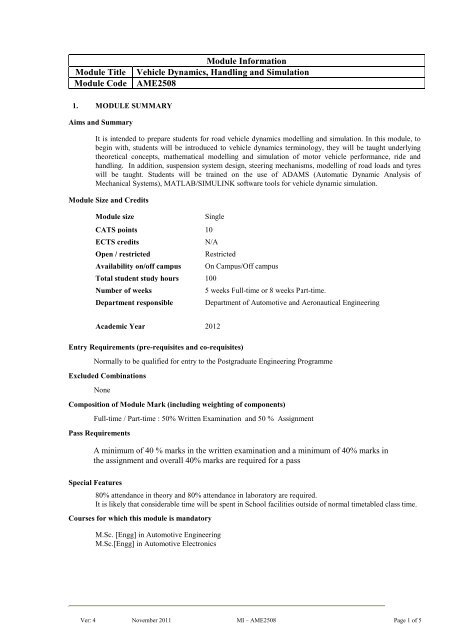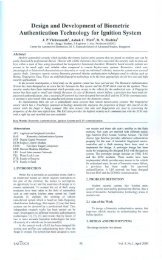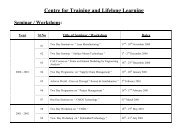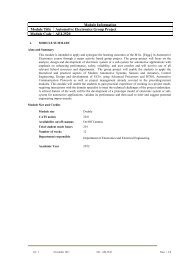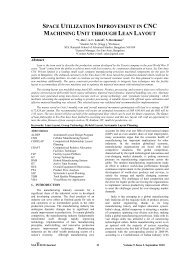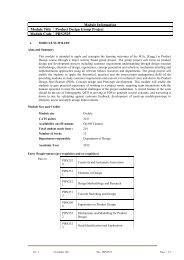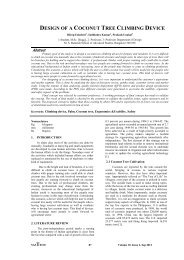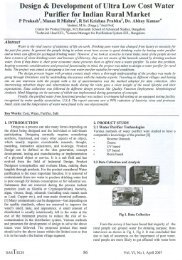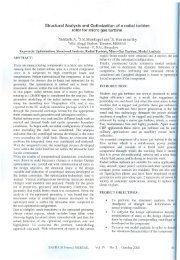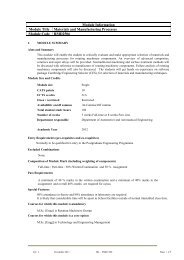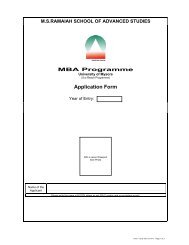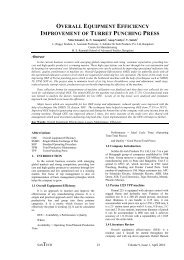AME2508 - MS Ramaiah School of Advanced Studies
AME2508 - MS Ramaiah School of Advanced Studies
AME2508 - MS Ramaiah School of Advanced Studies
Create successful ePaper yourself
Turn your PDF publications into a flip-book with our unique Google optimized e-Paper software.
Module Information<br />
Module Title Vehicle Dynamics, Handling and Simulation<br />
Module Code <strong>AME2508</strong><br />
1. MODULE SUMMARY<br />
Aims and Summary<br />
It is intended to prepare students for road vehicle dynamics modelling and simulation. In this module, to<br />
begin with, students will be introduced to vehicle dynamics terminology, they will be taught underlying<br />
theoretical concepts, mathematical modelling and simulation <strong>of</strong> motor vehicle performance, ride and<br />
handling. In addition, suspension system design, steering mechanisms, modelling <strong>of</strong> road loads and tyres<br />
will be taught. Students will be trained on the use <strong>of</strong> ADA<strong>MS</strong> (Automatic Dynamic Analysis <strong>of</strong><br />
Mechanical Systems), MATLAB/SIMULINK s<strong>of</strong>tware tools for vehicle dynamic simulation.<br />
Module Size and Credits<br />
Module size Single<br />
CATS points 10<br />
ECTS credits N/A<br />
Open / restricted Restricted<br />
Availability on/<strong>of</strong>f campus On Campus/Off campus<br />
Total student study hours 100<br />
Number <strong>of</strong> weeks 5 weeks Full-time or 8 weeks Part-time.<br />
Department responsible Department <strong>of</strong> Automotive and Aeronautical Engineering<br />
Academic Year 2012<br />
Entry Requirements (pre-requisites and co-requisites)<br />
Normally to be qualified for entry to the Postgraduate Engineering Programme<br />
Excluded Combinations<br />
None<br />
Composition <strong>of</strong> Module Mark (including weighting <strong>of</strong> components)<br />
Full-time / Part-time : 50% Written Examination and 50 % Assignment<br />
Pass Requirements<br />
A minimum <strong>of</strong> 40 % marks in the written examination and a minimum <strong>of</strong> 40% marks in<br />
the assignment and overall 40% marks are required for a pass<br />
Special Features<br />
80% attendance in theory and 80% attendance in laboratory are required.<br />
It is likely that considerable time will be spent in <strong>School</strong> facilities outside <strong>of</strong> normal timetabled class time.<br />
Courses for which this module is mandatory<br />
M.Sc. [Engg] in Automotive Engineering<br />
M.Sc.[Engg] in Automotive Electronics<br />
Ver: 4 November 2011 MI – <strong>AME2508</strong> Page 1 <strong>of</strong> 5
Courses for which this module is a core option<br />
M.Sc. [Engg] in Engineering and Manufacturing Management<br />
M.Sc. [Engg] in Technology and Engineering Management<br />
2. TEACHING, LEARNING AND ASSESSMENT<br />
Intended Module Learning Outcomes<br />
After undergoing this module, students will be able to:<br />
1. Explain and analyse tyre forces influencing vehicle acceleration and braking<br />
2. Model and simulate suspension characteristics<br />
3. Explain and analyse the models used in vehicle handling simulation<br />
4. Operate an industry standard dynamic analysis program (ADA<strong>MS</strong>) and perform suspension<br />
analysis, tyre modelling and vehicle handling / braking simulations<br />
Indicative Content<br />
Class Room Lectures<br />
1. Vehicle Dynamics Terminology - Vehicle Dynamics System and Simulation, Axis/coordinate<br />
System, Wheelbase, Wheel track or tread width, Sprung/Un-sprung weight, Curb weight, Center <strong>of</strong><br />
gravity height, Weight distribution, Projected Steering Axis, Caster/Caster trail, Camber, Steering axis<br />
inclination, Scrub Radius, Toe, Ackermann steer, Under-steer, Neutral steer, Over-steer, Neutral steer<br />
point, Static margin, Characteristic speed, Critical speed, Instant centers ,Roll centers/Roll axis, Anti-<br />
Squat/Anti-Dive, Road Loads/Tractive forces, Spring centers, Bounce centers/nodes, Pitch<br />
centers/node, Ride frequencies, Wheel/Tire/Un-sprung frequencies, Roll frequencies,<br />
Damping/Damping coefficients<br />
2. Tire Fundamentals and Dynamic Characteristics - Traction limits, Friction circle, Slip angle,<br />
Cornering stiffness, Carpet plot, Self-aligning torque, Camber thrust, g-g diagram<br />
3. Acceleration Performance - Engine power limited acceleration: Effect <strong>of</strong> transmission, Engine<br />
power, Power train component inertia on acceleration, Traction limited acceleration, Effect <strong>of</strong> weight<br />
transfer on traction limits for rear wheel and front wheel drive vehicles, Driving cycle and fuel<br />
consumption<br />
4. Braking Performance - General equation for braking, Braking forces, Brakes and brake system,<br />
Brake factor, Tire load friction, Braking coefficient and slip, Federal requirements for braking<br />
Performance, Brake proportioning, Anti lock Brake Systems, Braking Efficiency<br />
5. Ride - Meaning <strong>of</strong> ride, Subjective and objective engineering, Road surface irregularities, Power<br />
Spectral Density, Spectral densities <strong>of</strong> road elevation pr<strong>of</strong>iles, Tire and wheel excitations, Drive line<br />
excitation, Engine excitations, Vehicle response to excitations, Active vibration control, Wheel hop<br />
resonance, Suspension non-linearities, Bounce and pitch motions, Human perception and tolerance <strong>of</strong><br />
vibrations<br />
6. Vehicle Handling (Steady and Transient) - Low speed turning, High speed cornering, Suspension<br />
effects on cornering, Roll moment distribution, Camber change, Roll steer, Lateral force compliance<br />
Steer, Aligning torque, Effect <strong>of</strong> tractive forces on cornering, Transient handling, road testing<br />
7. Suspensions - Automotive suspension, Functions <strong>of</strong> automotive suspension system, Suspension<br />
model, Conventional suspension system, Semi-active suspension systems and control, Active<br />
suspension system and control<br />
8. Steering System - Steering principles and layouts, Steering systems, Wheel alignment angles<br />
9. Roll Over - Quasi-static rollover <strong>of</strong> a rigid vehicle, Quasi-static rollover <strong>of</strong> a suspended vehicle,<br />
Transient roll over, Roll over demonstrations<br />
10. Tyre testing and tyre modelling techniques<br />
Laboratory Practice<br />
1. Introduction to ADA<strong>MS</strong>/View, ADA<strong>MS</strong>/CAR<br />
2. Kinematic and Dynamic Simulation <strong>of</strong> Simple Mechanisms using ADA<strong>MS</strong><br />
3. Geometric Modelling, Template Creation in ADA<strong>MS</strong><br />
4. Road Modelling<br />
5. Building Car Models<br />
6. Acceleration, Braking, Suspension and Handling Simulation<br />
Ver: 4 November 2011 MI – <strong>AME2508</strong> Page 2 <strong>of</strong> 5
7. Tyre Modelling<br />
8. Lumped Modelling <strong>of</strong> Vehicles<br />
9. Solving Lumped Model equations using MATLAB/SIMULINK<br />
10. Driving manoeuvres using driving simulator<br />
11. Visiting proving grounds to observe<br />
a. Instrumentation for road testing <strong>of</strong> vehicles<br />
b. Data Collection and Interpretation<br />
Teaching and Learning Methods<br />
1. Theoretical Knowledge<br />
a. Face to face lectures<br />
2. Laboratory Practice (Skills)<br />
3. Application Orientation and Problem Solving<br />
a. Reading<br />
b. Research<br />
c. Written Examination<br />
d. Assignment Solving and Documentation<br />
Method <strong>of</strong> Assessment<br />
Part-A<br />
Examination [50% Weightage]<br />
Part-B<br />
Re-assessment<br />
1. Viva/Presentation on a specified topic............................................... (10%)<br />
2. Student performance on classroom tests............................................. (10%)<br />
3. Written examination..............................................................................(30%)<br />
Assignment [50% Weightage]<br />
Students are required to submit a word processed assignment report.<br />
Assessment<br />
Learning Outcomes 1 2 3 4<br />
Part A X X X<br />
Part B X X X X<br />
Both written examination scripts and assignment reports will be double marked.<br />
30 hours<br />
30 hours<br />
40 hours<br />
A minimum <strong>of</strong> 40 % marks in the written examination and a minimum <strong>of</strong> 40% marks in the assignment are<br />
required for a pass in the module.<br />
A student failing in any one <strong>of</strong> the components or both is considered as FAIL in the module. A failed<br />
student is required to retake the module at the next opportunity. A maximum <strong>of</strong> 3 attempts including the<br />
original are allowed.<br />
Ver: 4 November 2011 MI – <strong>AME2508</strong> Page 3 <strong>of</strong> 5
Date <strong>of</strong> Last Amendment<br />
November 2011<br />
3. MODULE RESOURCES<br />
Essential Reading<br />
1. Module Notes<br />
Recommended Reading<br />
Books<br />
Laboratory<br />
1. T.D. Gillespie. (1992) Fundamentals <strong>of</strong> vehicle dynamics, Society <strong>of</strong> Automotive Engineers (SAE).<br />
2. W. Milliken and D. Milliken. (1995) Race Car Vehicle Dynamics, Society <strong>of</strong> Automotive Engineers<br />
(SAE).<br />
3. W. Milliken and D. Milliken. (2002) Chassis Design – Principles and Analysis, Society <strong>of</strong><br />
Automotive Engineers (SAE).<br />
4. J.Y. Wong. (2001) Theory <strong>of</strong> Ground Vehicles, 3 rd edition, John Wiley & Sons.<br />
5. H. Rahnejat. (1998) Multi-body Dynamics-Machines, Vehicle and Mechanisms, Mechanical<br />
Engineering Publications.<br />
6. M. Blundell and D. Harty. (2004) The Multibody Systems Approach to Vehicle Dynamics, Elsevier<br />
Science.<br />
7. G. Genta. (1997) Motor Vehicle Dynamics. Modeling and Simulation, World Scientific.<br />
Journals<br />
1. International Journal <strong>of</strong> Vehicle Mechanics and Mobility, Taylor and Francis<br />
2. International Journal <strong>of</strong> Vehicle Systems Modelling and Testing, Inderscience Publishers<br />
Magazines<br />
1. Automotive Engineering International<br />
2. Autocar INDIA<br />
3. Overdrive<br />
Internet Sites<br />
Hardware: PCs<br />
S<strong>of</strong>tware: <strong>MS</strong>C.ADA<strong>MS</strong>, MATLAB/SIMULINK<br />
S<strong>of</strong>tware Manual: <strong>MS</strong>C.ADA<strong>MS</strong><br />
4. MODULE ORGANISATION<br />
Module Leader<br />
Name Dr. S.R. Shankapal<br />
Room B307<br />
Telephone number 080 4906 5555 Extn:2203<br />
E-mail srspal@msrsas.org<br />
Date and Time <strong>of</strong> Examination<br />
As per the time table<br />
Ver: 4 November 2011 MI – <strong>AME2508</strong> Page 4 <strong>of</strong> 5
Subject Quality and Approval Information<br />
Subject Quality Group / Subject Board Automotive and Aeronautical Engineering<br />
Subject Assessment Board Postgraduate Engineering and Management Programmes<br />
Shortened title VDHS<br />
Date <strong>of</strong> approval by MARP November 2011<br />
Ver: 4 November 2011 MI – <strong>AME2508</strong> Page 5 <strong>of</strong> 5


